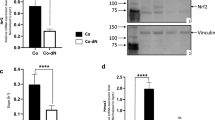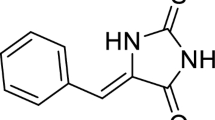Abstract
Dinitrotoluene (DNT), an important industrial nitroaromatic compound, is a potent hepatocarcinogen in rats. Male Fischer-334 rats fed technical-grade DNT in the diet for 12 months showed a 100% incidence of hepatocellular carcinomas1. However, various in vitro and in vivo short-term tests using several genotoxic end points have failed to show activity with DNT or purified DNT isomers2–6, including unscheduled DNA synthesis (UDS) in primary hepatocytes in vitro7. In the in vivo–in vitro hepatocyte DNA repair assay, which measures chemically induced UDS in hepatocytes isolated from rats treated in vivo8, DNT was found to be a potent UDS inducer9 having a peak of activity 12 h after a single dose. A possible explanation for the discrepancy between the in vivo and in vitro results is that metabolism by gut flora may be required for formation of the proximate or ultimate carcinogenic metabolites of DNT. The importance of biotransformation of toxicants by intestinal microflora has been demonstrated for cycasin10,11 and other xenobiotics12. We have used the in vivo–in vitro hepatocyte DNA repair assay to study the role of intestinal microflora in DNT genotoxicity. We report here extensive DNT-induced DNA repair in rats having the normal complement of gut flora, but not in rats which have no gut flora. These results indicate that metabolism of DNT by gut flora is a necessary step in the genotoxicity of this compound and illustrate the value of the in vivo–in vitro hepatocyte DNA repair assay in assessing the carcinogenic potential of nitroaromatic compounds.
This is a preview of subscription content, access via your institution
Access options
Subscribe to this journal
Receive 51 print issues and online access
$199.00 per year
only $3.90 per issue
Buy this article
- Purchase on Springer Link
- Instant access to full article PDF
Prices may be subject to local taxes which are calculated during checkout
Similar content being viewed by others
References
Chemical Industry Institute of Toxicology, Docket 3278 (1978).
Abernethy, D. J. & Couch, D. B. Mutat. Res. (in the press).
Chiu, C. W., Lee, L. H., Wang, C. Y. & Bryan, G. T. Mutat. Res. 58, 11–22 (1978).
Dougherty, R. W., Simon, G. S., Campbell, F. I. & Borzelleca, J. F. Pharmacologist 20, 155 (1978).
Simmon, V. F., Eckford, S. L., Griffin, A. F., Spanggord, R. & Newell, G. W. Toxic. appl. Pharmac. 41, 197 (1977).
Soares, E. R. & Lock, L. F. Envir. Mutagen. 2, 111–124 (1980).
Bermudez, E., Tillery, D. & Butterworth, B. E. Envir. Mutagen. 1, 391–398 (1979).
Mirsalis, J. C. & Butterworth, B. E. Carcinogenesis 1, 621–625 (1980).
Mirsalis, J. C. & Butterworth, B. E. Envir. Mutagen. 3, 316 (1981).
Hill, M. J. J. hum. Nutr. 33, 416–426 (1979).
Canvanna, M. et al. Br. J. Cancer 39, 383–390 (1979).
Williams, R. T. Toxic appl. Pharmac. 23, 769–781 (1972).
Rickert, D. E., Long, R. M., Krakowka, S. & Dent, J. G. Toxic. appl. Pharmac. 59, 574–579 (1981).
Guest, D., Schnell, S. R. & Dent, J. G. The Toxicologist 1, 110 (1981).
Bond, J. A. & Rickert, D. E. Drug Metab. Disposit. 9, 10–14 (1981).
Hollstein, M., McCann, J., Angelosanto, F. A. & Nichols, W. W. Mutat. Res. 65, 133 (1979).
Author information
Authors and Affiliations
Rights and permissions
About this article
Cite this article
Mirsalis, J., Hamm, T., Sherrill, J. et al. Role of gut flora in the genotoxicity of dinitrotoluene. Nature 295, 322–323 (1982). https://doi.org/10.1038/295322a0
Received:
Accepted:
Issue Date:
DOI: https://doi.org/10.1038/295322a0
This article is cited by
-
Modulation of DNA synthesis in aortic smooth muscle cells by dinitrotoluenes
Cell Biology and Toxicology (1991)
-
Examination of potential mechanisms of carcinogenicity of 1,4-dioxane in rat nasal epithelial cells and hepatocytes
Archives of Toxicology (1991)
-
In Vivo measurement of unscheduled DNA synthesis and S-phase synthesis as an indicator of hepatocarcinogenesis in rodents
Cell Biology and Toxicology (1987)
-
Non-genotoxicity of 2,4,6-Trinitrotoluene (TNT) to the mouse bone marrow and the rat liver: implications for its carcinogenicity
Archives of Toxicology (1985)
Comments
By submitting a comment you agree to abide by our Terms and Community Guidelines. If you find something abusive or that does not comply with our terms or guidelines please flag it as inappropriate.



